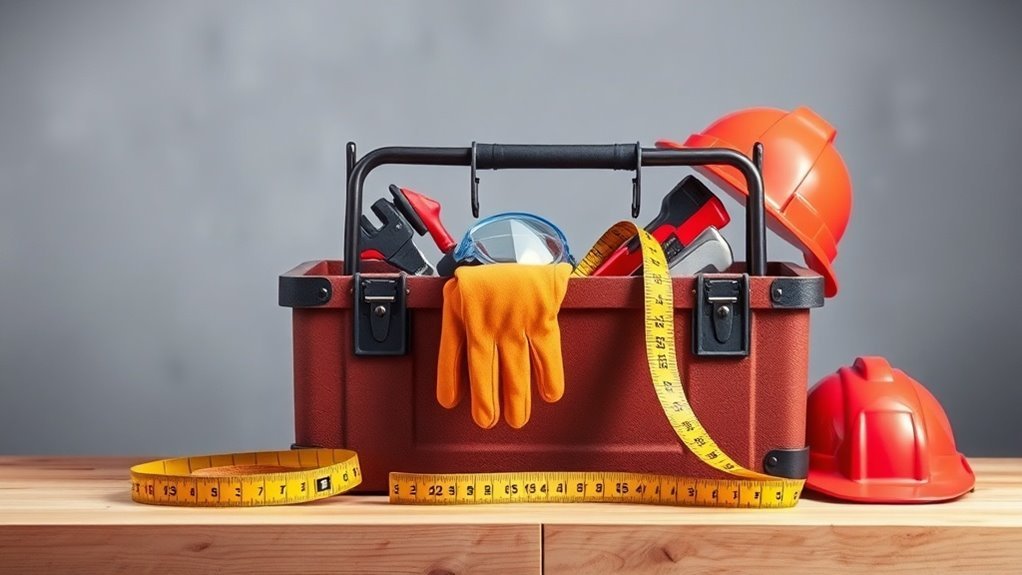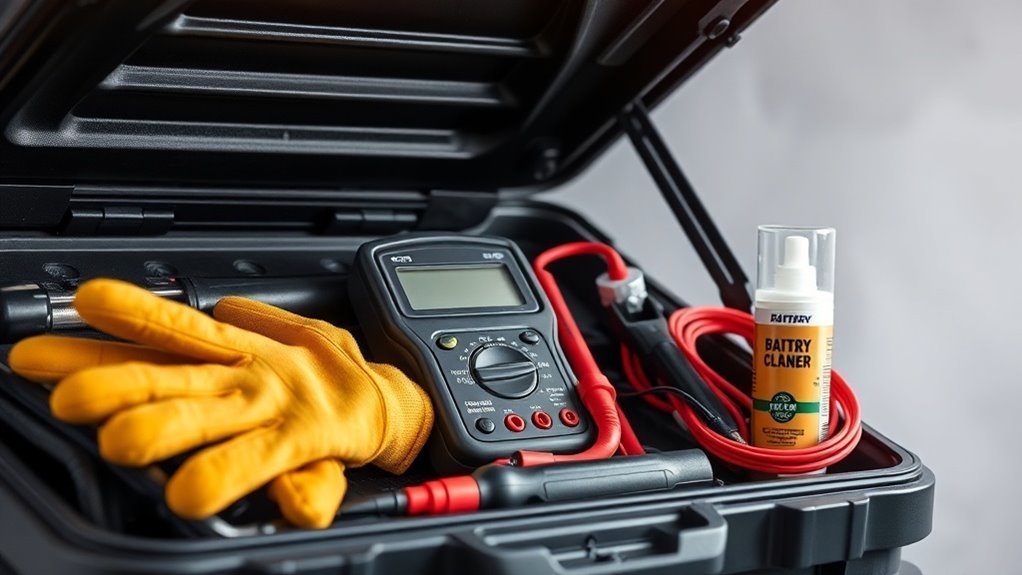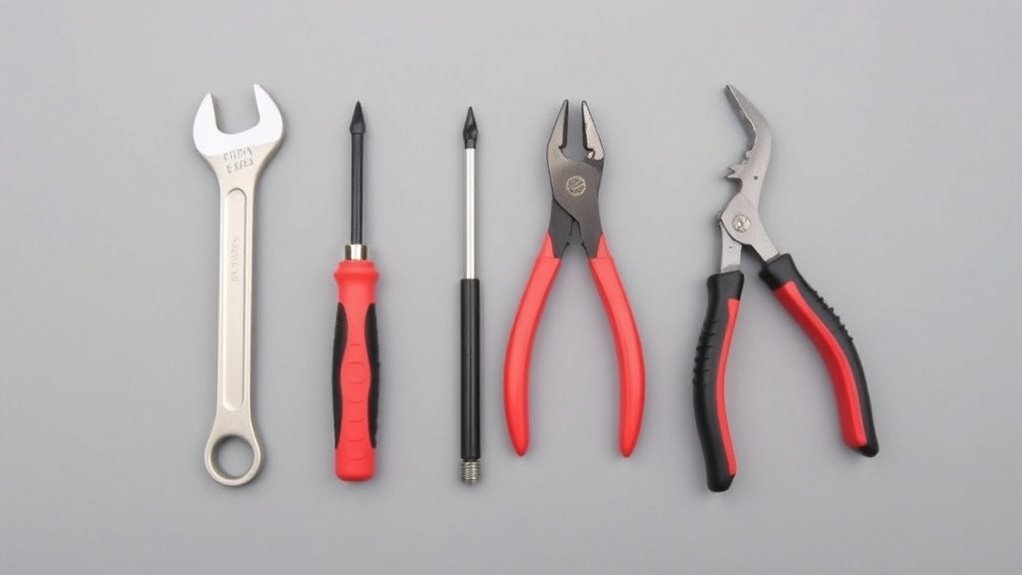Safety Gear Required for DIY Car Repairs
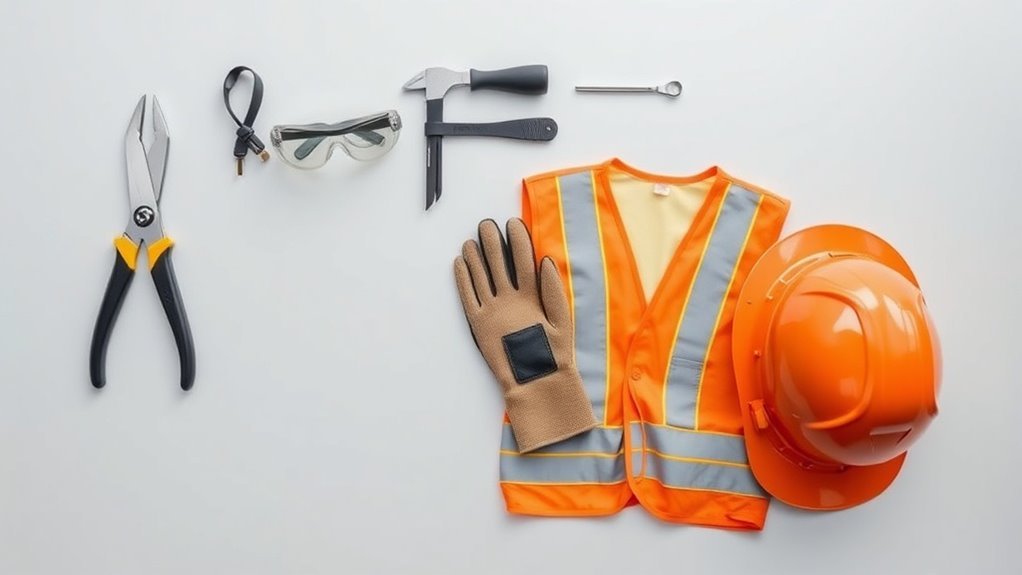
When tackling DIY car repairs, safety gear is a must. You’ll need essential gloves to protect your hands, goggles or safety glasses for your eyes, and ear protection to shield against loud noises. Durable work boots prevent foot injuries, while respirators and dust masks help you breathe safely around fumes and dust. Coveralls and work aprons keep you clean and protected. A well-stocked first aid kit is also crucial for treating minor injuries. There’s more to learn about each of these essential items.
Key Takeaways
- Always wear safety goggles or glasses to protect your eyes from debris and chemicals during car repairs.
- Use nitrile or heavy-duty leather gloves to handle oils, chemicals, and sharp tools safely.
- Invest in steel-toed boots or slip-resistant footwear to protect your feet from heavy equipment and prevent slips.
- Utilize ear protection, such as earplugs or earmuffs, to guard against loud machinery noise during repairs.
- Don a respirator or dust mask when sanding or painting to shield against harmful fumes and dust exposure.
Importance of Safety Gear in Car Repairs
When you’re tackling DIY car repairs, wearing the right safety gear is essential, as it helps protect you from potential hazards. Every time you lift a tool or dive under the hood, you expose yourself to risks like sharp edges, flying debris, and harmful chemicals.
A sturdy pair of safety goggles shields your eyes, while ear protection can save you from long-term hearing damage when working with loud machinery. Steel-toed boots provide foot protection against heavy tools, and kneepads keep your knees safe when you’re crouching for extended periods. Additionally, using high-quality extension cords can help prevent electrical hazards while working in your garage or workshop.
Essential Gloves for Protecting Your Hands
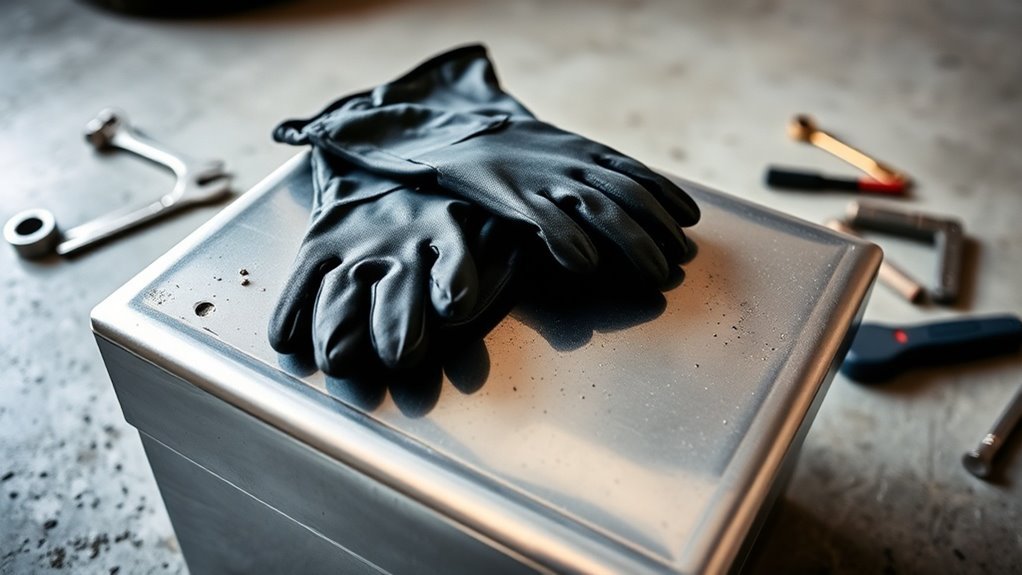
While you might underestimate their importance, wearing the right gloves during car repairs can greatly protect your hands from cuts, burns, and chemical exposure.
First, consider nitrile gloves; they’re excellent for handling oils and chemicals without risking skin contact. If you’re working with sharp components, heavy-duty leather gloves provide great protection against cuts and punctures.
For jobs involving heat, like working with exhaust systems, heat-resistant gloves are essential. It’s important to avoid cotton gloves, as they can absorb oils and offer little protection.
Choose gloves that fit snugly to maintain dexterity while ensuring they’re thick enough to shield against potential hazards. Investing in quality gloves not only safeguards your hands but also makes your DIY repair experience smoother and safer. Additionally, effective respiratory protection is crucial when dealing with hazardous materials, as it prevents long-term health issues.
Protective Eyewear: Goggles vs. Safety Glasses
Choosing the right protective eyewear is essential for anyone tackling DIY car repairs.
You’ll want to evaluate both goggles and safety glasses, each offering unique benefits. Safety glasses are lightweight and comfortable, providing good protection against dust and debris. They’re ideal for lighter tasks where you’re not dealing with larger projectiles.
On the other hand, goggles offer a more secure seal around your eyes, making them better for high-risk jobs involving chemicals or flying particles. They prevent dust and other materials from entering, ensuring maximum protection.
Additionally, selecting eyewear with specific lens types can enhance your safety by catering to the particular demands of your repair tasks.
Ultimately, the choice depends on your specific repair tasks. Reflect on the potential hazards you’ll face, and select eyewear that meets your needs for safety and comfort while working on your vehicle.
Ear Protection for Noise Reduction
Since DIY car repairs often involve loud tools and machinery, it’s essential to prioritize ear protection to prevent hearing damage.
Using earplugs or earmuffs can greatly reduce noise exposure, shielding your ears from harmful sound levels. When choosing ear protection, consider comfort and fit, especially if you’ll be wearing them for extended periods.
Foam earplugs are affordable and compact, while earmuffs offer more protection and can be worn over glasses. If you’re using particularly loud equipment like impact wrenches or grinders, opt for higher noise reduction ratings. Additionally, the materials and design features of ear protection significantly influence their effectiveness in blocking out harmful sounds.
Durable Work Boots for Foot Safety
When you’re working on your car, having the right work boots is vital for foot safety.
You’ll want to think about essential features like steel-toe versus composite options, as well as comfort during those long repair sessions. Steel toe caps enhance the durability of shoes, safeguarding your feet from heavy objects and potential hazards. Choosing the right boots can make all the difference in preventing injuries and keeping you comfortable on the job.
Essential Features to Consider
While you might focus on tools and parts during DIY car repairs, it’s essential not to overlook the importance of durable work boots for foot safety.
When choosing boots, consider features like slip-resistant outsoles to prevent falls on slippery surfaces. Look for waterproof materials to keep your feet dry and comfortable, especially if you’re working on wet days.
Good insulation can also protect your feet from extreme temperatures. Breathable materials help maintain comfort during long repair sessions. Additionally, a snug fit around the ankle provides support and prevents injuries.
Finally, verify the boots are lightweight to avoid fatigue while you’re on your feet. Investing in these features will help protect you and keep your focus on the task at hand.
Steel-Toe vs. Composite Options
Choosing the right work boots goes beyond just comfort and support; it’s also about protection.
When it comes to foot safety for DIY car repairs, you’ve got two main options: steel-toe and composite-toe boots. Each type has its own benefits that suit different needs.
- Steel-Toe Boots: Great for heavy-duty protection and impact resistance. They’re usually more affordable but can be heavier.
- Composite-Toe Boots: Lighter and more comfortable than steel-toe options, they’re non-metallic and often provide better thermal insulation.
- Durability: Both options offer excellent durability, but remember, the choice depends on your work environment and personal preference.
Consider what fits your DIY repair needs best, ensuring your feet stay safe while you work.
Comfort for Extended Wear
A solid pair of work boots should keep your feet comfortable, especially during long DIY car repairs. You’ll want boots that provide ample support, cushioning, and breathability to prevent fatigue.
Look for features like shock-absorbing insoles and moisture-wicking materials, which help keep your feet dry and comfortable. A lightweight design can also be a game changer; heavy boots can weigh you down and cause discomfort over time.
Consider options that have a padded collar and tongue for added comfort. Don’t forget about the fit—boots that fit snugly without being too tight will guarantee you can focus on your work instead of your sore feet.
Comfort goes hand-in-hand with safety, making the right footwear essential for your DIY projects.
Respirators and Dust Masks for Breathing Safety
When you’re working on DIY car repairs, protecting your lungs is just as important as safeguarding your feet.
There are different types of respirators and dust masks designed for various tasks, and knowing which one to use can make a big difference.
It’s vital to follow proper usage guidelines to guarantee you’re getting the protection you need while you work.
Types of Respirators
While working on DIY car repairs, it’s crucial to protect your lungs from harmful particles and fumes, making the right respirator a significant piece of safety gear.
Choosing the right type of respirator guarantees you’re adequately protected during your projects.
Here are three common types you should consider:
- Disposable Dust Masks: Suitable for low exposure to non-toxic particles; easy to use and cost-effective.
- Half-Face Respirators: Provide better filtration against specific fumes and particles, often with replaceable filters.
- Full-Face Respirators: Offer complete protection for your mouth, nose, and eyes, ideal for dealing with hazardous gases and vapors.
Investing in the right respirator can enhance your safety while you tackle those car repair tasks.
Proper Usage Guidelines
To guarantee your safety during DIY car repairs, following proper usage guidelines for respirators and dust masks is essential.
First, always choose a respirator or mask rated for the specific hazards you’re dealing with, such as paint fumes or dust.
Before putting it on, check for any damage; a compromised mask won’t offer adequate protection.
Ascertain a snug fit by adjusting straps and seals—air leaks can let harmful particles in.
When wearing a respirator, avoid touching it with dirty hands, and replace filters regularly to maintain effectiveness.
Finally, store your gear in a cool, dry area when not in use.
Coveralls and Work Aprons for Body Protection
Coveralls and work aprons are essential for protecting your body during DIY car repairs, as they shield you from dirt, grease, and sharp objects.
Wearing these pieces of gear not only keeps you clean but also adds a layer of safety.
Here are a few key benefits of using coveralls and work aprons:
- Durable Protection: They prevent physical injuries from sharp tools or parts.
- Easy to Clean: Most coveralls and aprons are machine washable, making post-repair cleanup effortless.
- Convenient Storage: Many aprons come with pockets, allowing you to keep tools close at hand for quick access.
Moreover, investing in quality coveralls and aprons ensures effective and reliable protection in line with recognized safety standards.
Investing in quality coveralls and aprons is a smart choice for any DIY car repair enthusiast.
Investing in high-quality coveralls and aprons elevates your DIY car repair experience with safety and convenience.
Stay safe and tidy while you work!
First Aid Kits: Preparing for the Unexpected
Even with proper protective gear like coveralls and work aprons, accidents can still happen during DIY car repairs.
That’s why having a well-stocked first aid kit is essential. You never know when you might get a cut, scrape, or even a burn while working on your vehicle.
Make sure your kit includes adhesive bandages, antiseptic wipes, gauze pads, and medical tape. Don’t forget items like tweezers for splinters and scissors for cutting bandages. A cold pack can also come in handy for bumps or bruises.
Regularly check your kit to replace any expired items, ensuring you’re always prepared.
Questions
How Often Should Safety Gear Be Replaced?
You should replace safety gear every 1-2 years, or sooner if you notice wear and tear. Regular checks will guarantee your gear remains effective, helping to keep you protected during any hands-on projects.
Can I DIY Repairs Without Safety Gear?
Sure, you can totally DIY repairs without safety gear—who needs protection, right? But honestly, it’s risky. You’re putting yourself in danger and can easily get injured. Just don’t skip the safety steps, okay?
Are There Specific Safety Standards for DIY Gear?
Yes, there are specific safety standards for DIY gear. These standards verify your gear meets necessary protection levels. You should always check for certifications to confirm your equipment protects you effectively during repairs.
What Is the Best Safety Gear for Beginners?
The best safety gear for beginners includes safety glasses to protect your eyes, gloves for hand protection, and earplugs if you’re working with loud tools. A sturdy pair of steel-toed boots is also essential for foot safety.
Do I Need Safety Gear for Minor Car Repairs?
Yes, you do need safety gear for minor car repairs. Even small tasks can pose risks. Protective eyewear, gloves, and sturdy footwear can help prevent injuries, ensuring you’re safe while working on your vehicle.
Conclusion
To sum up, equipping yourself with the right safety gear isn’t just smart; it’s crucial for ensuring that your DIY car repairs don’t turn into a fiasco. From gloves to respirators, each piece plays an essential role in safeguarding you during your work. Remember, you’re not just tinkering under the hood like a mechanic from a bygone era; you’re taking charge of your automotive fate. So gear up, and let safety be your steadfast companion on this journey!


